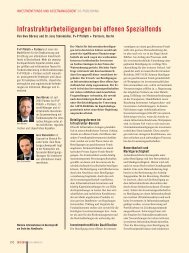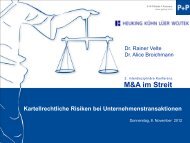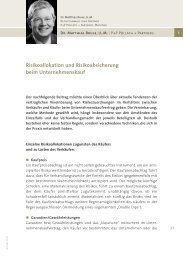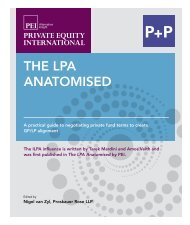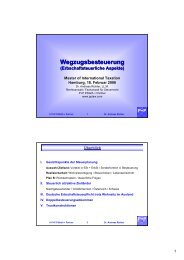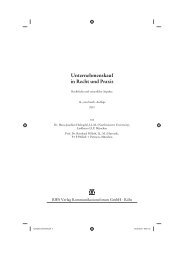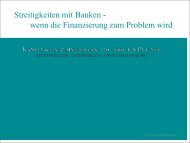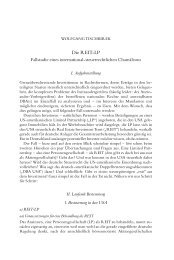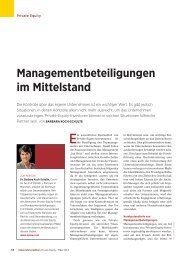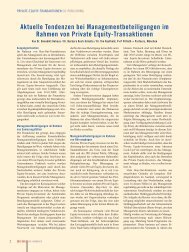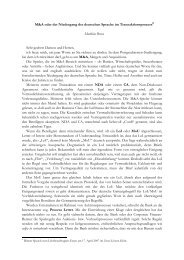Investissements étrangers en Allemagne Foreign Investments in ...
Investissements étrangers en Allemagne Foreign Investments in ...
Investissements étrangers en Allemagne Foreign Investments in ...
Create successful ePaper yourself
Turn your PDF publications into a flip-book with our unique Google optimized e-Paper software.
Fiscalité<br />
Taxation<br />
bb) Le pr<strong>in</strong>cipe des conditions normales de<br />
concurr<strong>en</strong>ce<br />
A<strong>in</strong>si, selon lepr<strong>in</strong>cipe des conditions normales de<br />
concurr<strong>en</strong>ce, les méthodes de transfert de prix<br />
(transfer pric<strong>in</strong>g methods) sont dev<strong>en</strong>ues lanorme<br />
dans les transactions transfrontalières. Le pr<strong>in</strong>cipe<br />
des conditions normales demarché requiert que la<br />
contrepartie pour toutes transactions <strong>in</strong>ter<strong>en</strong>treprises<br />
soit conforme au niveau qui aurait été appliqué<br />
si la transaction avait eu lieu <strong>en</strong>tre des parties<br />
non reliées <strong>en</strong>tre elles dans les mêmes conditions.<br />
Cep<strong>en</strong>dant, les différ<strong>en</strong>ts pays peuv<strong>en</strong>t utiliser<br />
d’autres méthodes pour calculer les prix detransfert<br />
appropriés (par exemple, «laméthode du prix<br />
de marché comparable», «laméthode du prix de<br />
rev<strong>en</strong>te », «laméthode ducoût majoré » ou «la<br />
méthode de partage des bénéfices »).<br />
Si et dans lamesure où le pr<strong>in</strong>cipe des conditions<br />
normales demarché n’est pas respecté àl’égard<br />
des transactions (nationales et <strong>in</strong>ternationales),<br />
l’assiette d’imposition de l’<strong>en</strong>treprise allemande<br />
pourrait être ajustée (au plus tard au cours d’un<br />
contrôle fiscal) par une déclaration d’impôt sur le<br />
rev<strong>en</strong>u/impôt sur les bénéfices des sociétés/taxe<br />
professionnelle (ajustem<strong>en</strong>t del’assiette) additionnelle<br />
et par des déductions fiscales (distributions<br />
de bénéfices cachés) le cas échéant. En outre, des<br />
pénalités peuv<strong>en</strong>t <strong>en</strong> résulter.<br />
Les autorités fiscales allemandes accept<strong>en</strong>t <strong>en</strong><br />
pr<strong>in</strong>cipe les standards de droit commun <strong>en</strong>matière<br />
de transfert deprix <strong>in</strong>ter<strong>en</strong>treprise, <strong>en</strong> particulier la<br />
méthode du prix de marché comparable, la méthode<br />
du prix de rev<strong>en</strong>te et la méthode du coût<br />
majoré.<br />
cc) Restrictions lat<strong>en</strong>tes<br />
En 2008, des changem<strong>en</strong>ts significatifs de la législation<br />
<strong>en</strong> <strong>Allemagne</strong> sur les prix de transfert ont<br />
été <strong>in</strong>troduits : un « transfert de fonctions » sera<br />
réputé avoir eulieu quand une fonction effectuée<br />
par une société est transférée àunautre groupe<br />
au-delà des frontières, même si le transfert est<br />
partiel ou temporaire. Dans ce «transfert de fonctions<br />
», les « fonctions » sont déf<strong>in</strong>ies comme le<br />
regroupem<strong>en</strong>t des tâches opérationnelles similaires,<br />
y compris les risques et opportunités correspondants,<br />
effectués par certa<strong>in</strong>s départem<strong>en</strong>ts<br />
de l’<strong>en</strong>treprise. De plus, le terme « transfert de<br />
fonctions »<strong>in</strong>clus aussi la reproduction des fonctions.<br />
Sous certa<strong>in</strong>es conditions, un prix de transfert<br />
approprié sera établi <strong>en</strong> fonction du prix m<strong>in</strong>imum<br />
du fournisseur etduprix maximum dudest<strong>in</strong>ataire.<br />
bb) Arm’s L<strong>en</strong>gth Pr<strong>in</strong>ciple<br />
H<strong>en</strong>ce, accord<strong>in</strong>g to the arm’s l<strong>en</strong>gth pr<strong>in</strong>ciple,<br />
transfer pric<strong>in</strong>g methods have become the accepted<br />
approach <strong>in</strong> deal<strong>in</strong>g with cross-border<br />
<strong>in</strong>tercompany transactions. The arm’s l<strong>en</strong>gth<br />
pr<strong>in</strong>ciple requires that consideration for any <strong>in</strong>tercompany<br />
transaction shall conform to the level<br />
that would have applied had the transaction tak<strong>en</strong><br />
place betwe<strong>en</strong> unrelated (third) parties under<br />
similar conditions. However, differ<strong>en</strong>t countries<br />
may accept differ<strong>en</strong>t methods (e.g. “comparable<br />
uncontrolled price method”, “resale price method”,<br />
“cost plus method” or “profit split method”) of<br />
calculat<strong>in</strong>g appropriate transfer prices.<br />
If and to the ext<strong>en</strong>t that the arm’s l<strong>en</strong>gth pr<strong>in</strong>ciple<br />
is not met with respect to (national as well as<br />
<strong>in</strong>ternational) transactions, the tax base of the<br />
respective German <strong>en</strong>tity might be adjusted (at<br />
the latest <strong>in</strong> the course ofatax audit) result<strong>in</strong>g <strong>in</strong><br />
an additional <strong>in</strong>come tax/corporate <strong>in</strong>come<br />
tax/trade tax burd<strong>en</strong> (adjusted tax base) and<br />
additional withhold<strong>in</strong>g taxes (hidd<strong>en</strong> profit distributions),<br />
as the case may be. Moreover, p<strong>en</strong>alty<br />
charges may result.<br />
German tax authorities basically accept the most<br />
common <strong>in</strong>tercompany transfer pric<strong>in</strong>g standards,<br />
<strong>in</strong> particular the comparable uncontrolled price<br />
method, resale price method and cost plus method.<br />
cc) Lat<strong>en</strong>t Restrictions<br />
In 2008, significant changes to Germany’s transfer<br />
pric<strong>in</strong>g legislation were <strong>in</strong>troduced: A“relocation<br />
of functions” will be deemed to have tak<strong>en</strong> place<br />
wh<strong>en</strong> afunction performed by one <strong>en</strong>tity istransferred<br />
cross-border to another group <strong>en</strong>tity, ev<strong>en</strong> if<br />
the transfer ispartial or temporary. In this context,<br />
“functions” are def<strong>in</strong>ed as the aggregation of<br />
similar operational tasks, <strong>in</strong>clud<strong>in</strong>g correspond<strong>in</strong>g<br />
opportunities and risks, executed by certa<strong>in</strong> departm<strong>en</strong>ts<br />
of the <strong>en</strong>terprise. Moreover, the term<br />
“relocation of functions” also <strong>in</strong>cludes the duplication<br />
of functions. Under certa<strong>in</strong> conditions, an<br />
appropriate transfer price will be established<br />
based on the supplier’s m<strong>in</strong>imum price and the<br />
recipi<strong>en</strong>t’s maximum price.<br />
64



